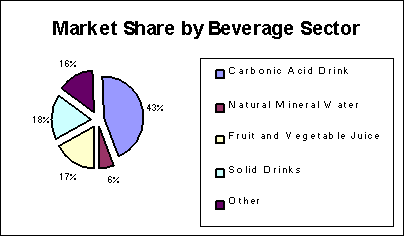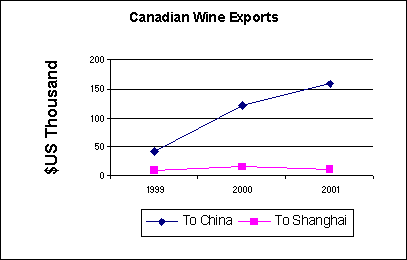

Beverages Market Report
Yangzi Delta Region
October 2002
Market Overview
The Chinese beverage market has been growing at a steady pace. Shanghai alone boasts a per capita annual expenditure on liquor and beverages almost two times the national average at CND $36.16 per year in 2000. The Consumption rate in Shanghai has grown 36% over the last three years, compared with a national growth rate of 13%.

Figure 1 China National Statistics Yearbook
Opportunities exist in China for a variety of Canadian beverage products. Careful planning and consideration should be undertaken before entering the market. The Chinese beverage industry is highly competitive, complex and constantly evolving. Shanghai is an important market for beverage products as the average spending per person is close to double that of the China average. As consumer income rises, the market will increase in importance.
Non-alcoholic Beverages
Soft Drinks
Soft drinks are the most popular beverage with Chinese consumers. Popular soft drinks such as Coke, Pepsi, Sprite and Fanta are readily visible at most stores and kiosks. Coke is the most popular drink capturing 33% of the soft drink sales. The Coca-Cola Company was one of the first foreign business ventures in China, and is considered as one of the most successful.

Foreign brands are performing well in the market. Foreign invested enterprises and imported beverage products are well represented in the market accounting for 61.6% of the market share. The main producers, such as Coke and Pepsi, have established joint-venture projects with Chinese companies and operate bottling plants in China. This allows for the product to meet local demand, adapt to market changes and produce lower priced products. The Yangtze Delta region is home to three of the top ten soft drink producers in China, with Zhejiang province number one in production.
There is a fast growing market for niche drinks. Cold tea drinks are becoming increasingly popular. Most international beverage makers from Asahi of Japan to Coca-Cola have recently added tea base drinks to their product lines. Some experts estimate these drinks will capture as much as a quarter of the market share in the next few years. Their low sugar content, refreshing qualities and cultural factor attribute to their success.
Fruit Juices
The demand for fruit and vegetable juice has been growing. Demand for foreign juice is increasing, as they are often viewed as better quality. Industry analysts predict that the average fruit juice consumption will double by 2005. As income increases, consumption will all increase. There is a trend among younger Chinese to move towards a healthier lifestyle. As the health benefits of fruit juice increase, demand should also.
There is significant domestic competition. China is quickly becoming an important exporter of fruit juices. Local fruit and vegetables can be purchased at low prices allowing Chinese companies to make juice cheaper than international imported products. International juices, as Dole and Tropicana, both sell at a premium and our aimed at the middle to high-income consumer.

The fruit and vegetable market is considered to be in its infancy. The average Chinese consumer drinks 1 litre of juice a year compared to the 50 to 70 litres consumed by Europeans and North Americans. The future market presents huge opportunity and huge growth. Tariffs will be lowered on all fruit and vegetable beverages entering China. Tariff reductions will occur at a gradual rate over the next couple of years reaching their lowest rate January 1, 2004.
The Chinese government has recently shifted their agricultural policy from land intensive to labour intensive production, such as fruit and vegetable cultivation. China hopes this move will maximise their resources and assist in WTO competition. The Chinese juice industry will have the increased ability to increase its production yield, offer low priced juices and become a key player in juice production.
Alcoholic Beverages
Beer
China is the second largest beer market in the world producing an annual output of 22 millions tonnes. In 2003, China is poised to overtake the United States and become the largest beer-consuming nation in the world. Although, the per capita consumption of the Chinese does not even come close in comparison to the average American, the sheer size of the population will make them number one.
| 1999 | 2000 (Est.) | 2003 (Forecast) | |
|---|---|---|---|
| USA | 17.6% | 16.8% | 16.2% |
| China | 15.5% | 17.3% | 18.6% |
| Germany | 8.1% | 7.5% | 6.9% |
| Brazil | 5.90% | 6.1% | 6.4% |
| UK | 4.60% | 4.1% | 3.8% |
Figure 2: Source Canasean
The Chinese beer market is one of the fastest growing markets in the world averaging a 6% growth rate. At present, many small, local breweries dominate the market creating tough competition. Of China's 400 domestic beer producers, only 18 have a capacity to produce above 200 000 tonnes. Of late, there has been a trend of consolidation with larger beer companies purchasing the smaller companies. Huge players include Tsingtao (China), South African Breweries, and Huaran group (Hong Kong). This consolidation trend will continue as China adapts to new market forces and their overseas competitors enter the market.
Canada is the 10th largest beer exporter to China, the Netherlands being number one. Beer companies employ different strategies when entering the market. Heineken imports all their beer sold in China, whereas Budweiser produces their beer in China. South African Brewery (SAB) partners with local brewers, improves the quality and sells under local brand names.
Shanghainese consumers value brand awareness, quality of the beer product and taste. Imported beers are often viewed as higher quality than local brands and therefore, enjoy a unique position in Shanghai. The income level is such, that consumers are willing to spend more on imported/ foreign beer. In general, price continues to be a sensitive issue with Chinese consumers. Chinese consumers prefer lower priced alternatives. As WTO tariffs fall, the price gap between foreign and domestic products will fall allowing imported beers to compete more readily with the local brands. A value-added tax of 17% continues to impede foreign brands from competing on the same level.
Wine
Traditionally, Chinese consumers were loyal to alcohol products such as beer or grain-based spirits. While the annual consumption per person averages approximately one glass of wine, the Shanghai and the Yangzi Delta region wine market displays considerable future potential for growth. Increased disposable income, western influences and a heightened health awareness fuel the wine market. Shanghai's disposable income, vibrant restaurant, hotel and bar industry and a consumer penchant for trying new things provides an excellent market for Canadian wine products.

Both domestic production and Chinese wine imports have increased. Domestic wine production has increased dramatically from 220 million litres in 1998 to 325 million litres in 2000 - a 48% increase. Canada was the 9th largest wine exporter to China. France dominated exports to Shanghai, with a 56% market share. Canada was the 15th largest wine exporter to Shanghai, with merely US$9,000 in exports.
Wine is mainly consumed on special occasions. As imported wine is considered a luxurious western product, it is used as a symbol of status and success. The target market is often the affluent younger generation. However the mass market is not as willing to pay high prices for imported wine. They prefer the cheaper local brands, with high alcohol levels.
For more detailed information, please refer to our Wine Market in the Yangzi Delta Region report, available through the Canadian Consulate in Shanghai.
Import Procedures and Distribution
Importers are required to obtain a business license from the "Industrial and Commercial Administration board" in order to import products. Wine products require an additional permit issued from the China National Cereals, Oils and Foodstuffs Import Export Corporation (CEROILS), the state monopoly traditionally responsible for wine imports. All imported products are subject to a food safety inspection before they enter the country. China Customs is constantly evolving to adopt WTO regulations and adapting to the new system. It is advisable to closely monitor this situation.
All imported beverages must adhere to the Chinese labelling regulations. All imported products must be affixed with a Chinese language label stating the product name, ingredients table, net weight, production date, expiry date, storage directions, country of origin, name and address of the importer and manufacturer. In addition, the law recommends standards such as the batch number, serving method, calories, and nutrients. Labelling refers to all written language, graphs, symbols, layout and explanation materials of packaged food products.
Effective November 1 2002, all imported and exported food product labels must be inspected, verified and issued a 'Certificate of Import Export Food Labelling' by the China State Administration for Entry-Exit Inspection and Quarantine headquarters (AQSIQ). AQSIQ specified laboratories shall test the food nutrition and quality to ensure that the label is accurate. An approval certificate is required prior to applying for goods-arrival inspection and other customs formalities.
An efficient distribution strategy is key to success. Canadian exporters can choose to either distribute their product directly through their own sales network, distribute through a wholesaler or with an agent. Each selection has its positives and negatives, and must be thoroughly examined by the exporter before entering the market. Another option is to establish a Joint-venture organization in China and produce locally.
For additional information on distribution, please refer to the "Food Distribution Systems in the Yangzi Delta Region" available through the Canadian Consulate in Shanghai.
Strategies and Recommendations
1. Canadian exporters must adopt an aggressive and consistent marketing campaign. This campaign should concentrate on promoting their brand and developing a loyal consumer base. As the market develops and competition increases, successful marketing will make the difference between success and failure.
2. Distribution remains a key problem. Interested exporters should evaluate their options carefully, and make decisions that best suit their company's needs.
3. The Chinese beverage market is large, highly competitive and complex. Exporters need to recognise that time, huge investment and patience is required to build brand awareness and garner success in the market. China is a long-term investment.
Import Regulations and Administration
1. Shanghai Customs of The People's Republic of China
- Responsible for the regulations and inspections on import and export
documents and certificates
Address: 13 Zhong Shan Dong Yi Lu
Shanghai 200002
Tel: 86-21-63232410
Fax: 86-21-63232095
Website: http://www.shcus.gov.cn
2. Shanghai Entry-Exit Inspection and Quarantine
Bureau of The People's Republic of China
- Responsible for the inspection of imported and exported goods
Address: 1208 Minsheng Road, Pudong New Area
Shanghai 200135
Tel: 86-21-68563030
Fax: 86-21-68565939
3. Shanghai Import Food Enterprise Association
- Provides assistance for the application and approval of labels for imported
foods
Address: Room 1702, Hero Building
2669 Xie Tu Road
Shanghai 200030
Tel: 86-21-64398189
Fax: 86-21-64398191
Additional Resources
For further information on the beverage market, please see the following detailed reports 'The Wine Market in the Yangzi Delta Region', 'The Bottled Water Market in the Yangzi Delta Region' and 'the Dairy market in the Yangzi Delta Region' available through the Consulate General in Shanghai.
Agriculture and Agri-Food Section
Canadian Consulate General
#604-1376 Nanjing West Road
Shanghai, 200040
Tel: (86-21) 6279-8400
Fax: (86-21) 6279-8401
E-mail: shirlie.wu@dfait-maeci.gc.ca
Henry Deng
Senior Commercial Officer
E-mail: henry.deng@dfait-maeci.gc.ca
Shirlie Wu
Commercial Assistant
E-mail: shirlie.wu@dfait-maeci.gc.ca
| Date Modified: 2004-06-30 | Important Notices |